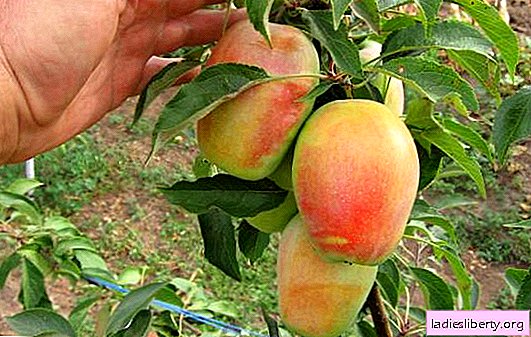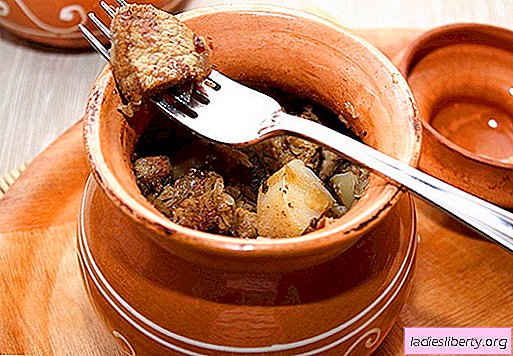
The apple-tree Sinap originates from the Crimean variety, which is famous for its excellent taste, but does not tolerate frost and a cold Russian climate. The breeder Michurin has developed a number of more frost-resistant varieties that are not worse in taste than the Crimean apple tree. These trees quickly took root in the gardens of the middle lane.
Varieties of apple synap: description of varieties
Sinap variety includes several varieties of apple trees with similar characteristics:
• good taste of the fruit;
• high transportability and preservation of the crop;
• high resistance to scab and frost;
• early maturity.
There are several varieties of apple trees: Sinap Severny, Oryol, Gorny, Belorussky, Kandil, Almaty, Bogatyrsky, Khakass, Minusinsky.

Sinap Gorny is considered a young apple tree, a variety used for planting since 2009 in the northwestern regions of the country. The tree is self-fertile, bears fruit in large fruits, whose weight is more than 250 g. Apples are delicious, stored for a long time. The variety is characterized by high winter hardiness.
The Belarusian Sinap is less popular among gardeners because of the mediocre taste of fruits. Apples of medium size, their flesh is juicy. Harvest ripens by the end of September, is well stored until spring. The fruits are used for drying and processing. The tree is tall.
The most productive is the Sinap Kandil variety. An adult tree produces more than 250 kg of fruit. The variety is heat-loving, comes into fruition late, periodic crops.

Bogatyrsky synap is valued for its high and stable crops. The fruits are tasty, large, well stored and do not lose their presentation for more than six months.
Apple-tree Almaty Sinap is medium-sized, bears fruit early. The fruits are medium-sized, ready for harvest in late September - early October.
The Khakassky Synap does not produce large crops; an adult tree brings no more than 50 kg of fruit. However, the variety is valued for its good keeping quality and fruit taste, their ability to stay on branches for a long time and not crumble.
The Minusinsk synap is grown mainly in the northern regions. The tree bears fruit in small fruits, the weight of which does not exceed 50 g. The apples are tasty, sweet and sour, seasoned.
Sinap Severny: the advantages of the apple tree, the characteristics of the variety and its characteristics
The most popular and hardy is the self-fertile Sinap Severny variety. This is a vigorous apple tree of late maturity. Harvesting begins in late autumn and continues until frost. The tree is suitable for growing in regions of risky farming, tolerates harsh winters and drought.
The variety is early, the first fruits can be tasted after 5-6 years of cultivation. If you plant a tree grafted onto a dwarf rootstock, then it starts earlier, in the second or third year.
A high-yielding apple tree, an adult tree produces up to 170 kg of fruit. Stable fruiting lasts about 20 years, after which the plant should be replaced.
Fruits are delicious, fragrant, still, do not lose their presentation for 8 months. Apples are round in shape, medium in size, the skin is dense, covered with a waxy coating. Fully ripe green-yellow fruits with a red barrel. The pulp is fine-grained, quite juicy, sweet and sour taste with spicy notes.
Sinap Severny variety needs careful maintenance and proper planting. The tree does not tolerate heavy and too wet soils. In such conditions, growth slows down, fruiting does not occur. The seedling is placed in a well-lit area, away from large trees.
Apple-tree Sinap Orlovsky: description of the variety and tips for growing
The fruits of this variety are much larger than the previous, ripen late. Fruiting begins in the fifth year of cultivation. One young tree manages to collect at least 70 kg of apples. The variety is self-infertile. For greater productivity, you need to place pollinator trees nearby:
• Wellsie;
• "Saffron Pepin";
• "Antonovka".
Apples are round-conical in shape, with characteristic blunt ribs. The skin is golden yellow, dense, oily. The pulp is creamy, juicy, sweet and sour, with a weak aroma. The variety is suitable for fresh consumption and all types of processing.
The apple tree requires special care and regular watering, but it is not necessary to fill the soil. The soil is moistened no more than once a week during the period of drought and ripening of the crop. Water abundantly, up to 4 buckets of water are consumed per tree.
Among the disadvantages of the cultivar, late fruiting, the tendency to chop the fruit with plentiful harvests, are distinguished.
Tips for planting the Sinap apple tree: choosing the right place for the variety and preparing the soil
Sinap apple trees are grown in open, well-lit areas. Moreover, the site is chosen so that the groundwater level does not exceed two meters.
Planting seedlings is carried out in early spring or autumn, which depends on the region of cultivation. Autumn planting is preferable in the southern regions of the country. A pit for planting is prepared in advance, but not less than a month before the expected date. A hole is made deep, not less than a meter. The bottom is well drained, covered with prepared soil mixture. For this, fertile soil is mixed with mineral fertilizers, compost and humus. The pit is filled by a third and left to shrink.

The seedling is prepared a day before planting. The root system is saturated with moisture. To do this, lower the sapling with its roots in a nutrient solution or a bucket of water for 12 hours. Damaged roots are pruned.
Important! The root neck of the seedling should be located 5-7 cm above the soil level.
After planting, the tree is abundantly watered, the trunk circle is well mulched.
Sinap apple care: proper pruning, top dressing, pest control
The yield of an apple tree directly depends on pruning and crown formation. Pruning is carried out in the second year of cultivation, after planting, only dry and broken branches are cut.
Crown formation is done in spring. The central conductor in a young tree is cut by 40 cm, in an adult, it is slightly shortened. Shoots are cut by a third, forming a strong crown of skeletal branches. Be sure to remove growing inward and dry branches.
In the first year of cultivation, the apple tree is not fed, it is enough to correctly fill the compost pit. Further dressing is done according to the scheme:
• in early spring for digging the soil;
• on green kidneys;
• after flowering;
• after harvesting.
In the spring, use rotted manure or humus, at the rate of 500 grams per tree. When the kidneys swell, urea is closed along the perimeter of the trunk circle. The amount of fertilizer does not change. After flowering, it is useful to feed a solution of bird droppings and superphosphate. 50 g of superphosphate and a pound of bird droppings are bred in a bucket of water. In autumn, a superphosphate solution is introduced into the soil.
Sinap is considered highly resistant to diseases and pests, but preventive treatments will not interfere. In the spring, the tree is sprayed with wormwood and calcium preparations to protect it from the codling moth and bitter dimple. From other diseases, spraying with Bordeaux liquid or Fitosporin will help. After harvesting, it is useful to spray the crown with copper sulfate.
How the apple tree Sinap winters
The variety is considered winter hardy and suitable for cultivation in the northern regions of Russia. It tolerates a decrease in temperature well to - 37-40 ° C. However, a young tree without shelter can freeze. In the first years after planting, the apple tree must be covered, and the trunk circle is well mulched.











